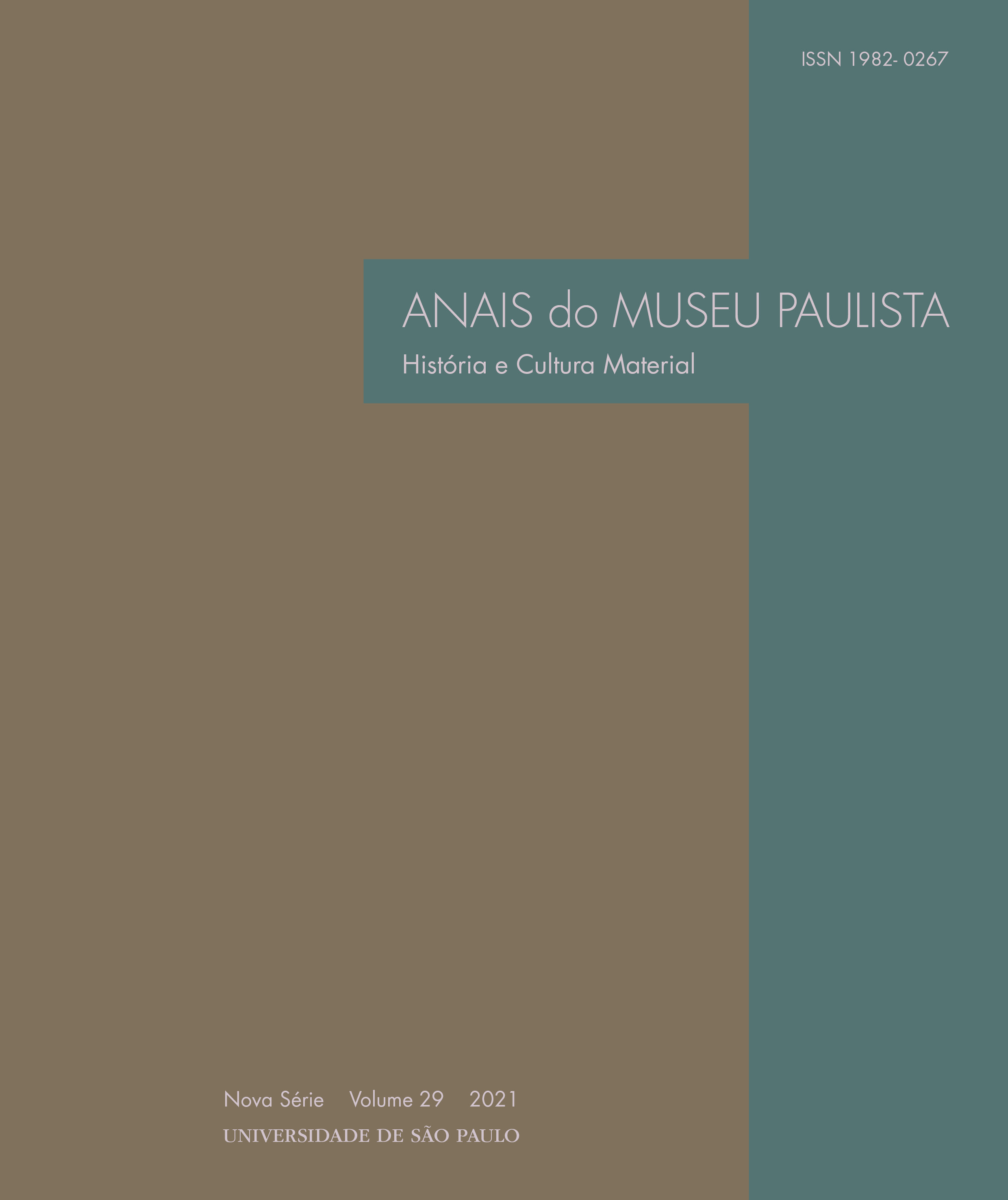Kimono: elucidating meanings of Japanese textile artifacts for a museum audience
DOI:
https://doi.org/10.1590/1982-02672021v29e9Palabras clave:
Japanese textiles, Material Culture, Semiotics, Textiles curation, Museum Programming, KimonoResumen
The objective of this research was to create museum texts and educational materials for a textiles section of a major year-long university museum exhibit focused on exploring Japanese culture and aesthetics through works of fine and applied art. Little background information about the textiles was available. A sample of historical Japanese kimono, yukata, and obi in a university
collection was examined using material culture and semiotics research methods. The motifs present in the textiles were identified and explored for how the motifs represent values relevant to Japanese cultural practices throughout time. In particular, motifs were analyzed for their noted conveyance of a society’s religious and cultural values. Motifs were predominantly botanical, emphasizing the respect for nature within Japanese culture. Other motif categories present included geometric, animals/insects, cultural/everyday objects, and landscape motifs. 104 individual motifs were identified. Symbolic meanings were examined and interpreted alongside present materials, colors, and techniques. The use of material culture and semiotics research methods for analyzing Japanese textiles is mapped in this study.
Descargas
Referencias
REFERENCES
BOOKS, ARTICLES, AND THESES
APPADURAI, Arjun. The social life of things: commodities in cultural perspective. Cambridge: Cambridge University Press, 1986.
AREO, Margaret Olugbemisola; KALILU, Razaq Olatunde Rom. Origin of and visual semiotics in Yoruba textile adire. Arts and Design Studies, [s. l.], v. 12, p. 2.224-6.061, 2013.
ATTFIELD, Judy. Wild things: the material culture of everyday life. Oxford: Berg, 2000.
BAIRD, Merrily. Symbols of Japan: thematic motifs in art and design. New York: Rizzoli, 2001.
DALBY, Liza. C. Kimono: Fashioning Culture. Seattle: University of Washington Press, 2001.
DEELY, John. Basics of semiotics. Bloomington: Indiana University Press, 1990.
DOWER, John. The elements of Japanese design: a Handbook of family crests, heraldry & symbolism. New York: Weatherhill, 1971.
EASTOP, Dinah. Material culture in action: conserving garments deliberately concealed within buildings. Anais do Museu Paulista: História e Cultura Material, [S. l.], v. 15, n. 1, p. 187-204, 2007. DOI: 10.1590/S0101-47142007000100004. Available from: <https://bit.ly/2O7zQOr>. Access on: Feb. 26, 2021.
GUNTER, Susan. Japanese design motifs and their symbolism as used on itajime-dyed juban. Athens: University of Georgia, 1999
INGOLD, Timothy. Materials against materiality. Archaeological Dialogues, Cambridge, v. 14, n. 1, p. 1-16, 2007. ISSN 1478-2294.
JACKSON, Anna. Kimono: the art and evolution of Japanese fashion. London: Thames & Hudson, 2015.
KRUGER, Kathryn Sullivan. Weaving the word: the metaphorics of weaving and female textual
production. Selinsgrove: Susquehanna University Press, 2001. ISBN 9781575910529.
MILLER, Daniel. Stuff. Cambridge: Polity Press, 2010.
PROWN, Jules. Mind in matter: an introduction to material culture theory and method. Winterthur Portfolio, Chicago, v. 17, n. 1, p. 1-19, 1982.
TAYLOR, Lou. Doing the laundry? A reassessment of object-based dress history. Fashion Theory: The Journal of Dress, Body, and Culture, Abingdon, v. 2, n. 4, p. 337-358, 1998. ISSN 1362-704X.
TIBBS, Kristen Marie. “Semiotics of the Cloth”: Reading Medieval Norse Textile Traditions. Huntington: Marshall University, 2012.
WONG, Dorothy. Buddhist pilgrim-monks as agents of cultural and artistic transmission: the international buddhist art style in East Asia, Ca. 645-770. Kent Ridge: NUS Press, 2018.
YANG, Sunny; NARASIN, Rochelle. Textile art of Japan. [S. l.]: Shufonotomo, 1989.
SITES
COLUMBIA UNIVERSITY. Japan: History-Archaeology. Asia for Educators, New York, 2020. Available from: <https://bit.ly/30jzTtd>. Access on: Nov. 15, 2019.
IKI-YA.COM & IKIYA.JP. Spring Attacks. Japanese Traditional Patterns and Traditional Colors. Tokyo, [20-?]. Available from: <https://bit.ly/2DqSlIy>. Access on: Oct. 23, 2019.
INDIANAPOLIS MUSEUM OF ART. Seven Gods of Good Fortune. Indianapolis, 2020. Available from: <https://bit.ly/3fhZDMA>. Access on: Nov. 6, 2019.
MATSUYAMA, Hiroko. Japanese Patterns: traditional motifs and designs. Patterns, [s. l.], 2017. Available from: <https://bit.ly/2On9JAh>. Access on: Oct. 29, 2019.
MELISSA. Motifs. Ready, Set, Kimono!, [s. l.], 2016. Available from: <https://readysetkimono.com/motifs/>. Access on: Dec. 15, 2019.
PARENT, Mary Neighbour. Seigaiha. Jaanus, [s. l.], 2001. Available from: <https://bit.ly/38I7ssu>. Access on: Nov. 18, 2019.
RICHMAN-ABDOU, K. The unique history and fascinating evolution of the Japanese kimono. My Modern Met, [s. l.], Dec. 25, 2017. Available from: <https://bit.ly/2Zg81qi>. Access on: Dec. 13, 2019.
TACHIICHI. What is nani? Japanese Pattern, [s. l.], 2020. Available from: <https://bit.ly/3iLHBV8>. Access on: Nov. 17, 2019.
THE IMPERIAL HOUSEHOLD AGENCY. Exhibition Outlines: No.35 The Modern Era of Shippo – Japanese Cloisonné (2004/7/3 – 2004/9/5). Tokyo, 2004. Available from: <https://bit.ly/3fgyxFR>. Access on: Oct. 24, 2019.
IOWA STATE UNIVERSITY. Contemplate Japan. University Museums, Ames, 2020. Available at: <https://bit.ly/2GX6Kyd>. Access on: Oct. 14, 2020.
Descargas
Publicado
Número
Sección
Licencia
Derechos de autor 2021 Sophia Luu, Ellen McKinney

Esta obra está bajo una licencia internacional Creative Commons Atribución 4.0.
Autores que publicam nesta revista concordam com os seguintes termos:
- Autores mantém os direitos autorais e concedem à revista o direito de primeira publicação, com o trabalho simultaneamente licenciado sob a Licença Creative Commons Attribution que permite o compartilhamento do trabalho com reconhecimento da autoria e publicação inicial nesta revista.
- Autores têm autorização para assumir contratos adicionais separadamente, para distribuição não-exclusiva da versão do trabalho publicada nesta revista (ex.: publicar em repositório institucional ou como capítulo de livro), com reconhecimento de autoria e publicação inicial nesta revista.
- Autores têm permissão e são estimulados a publicar e distribuir seu trabalho online (ex.: em repositórios institucionais ou na sua página pessoal) a qualquer ponto antes ou durante o processo editorial, já que isso pode gerar alterações produtivas, bem como aumentar o impacto e a citação do trabalho publicado (Veja O Efeito do Acesso Livre).



